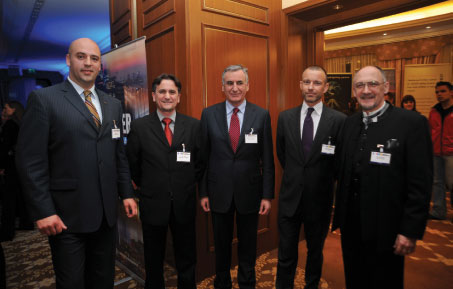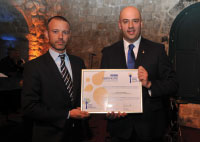
As the year kicked off with promising signs of traffic growth, there was a palpable optimism in the air, as regional airports came from far and wide, to debate and exchange, network and socialise amid the bright, Adriatic charms of Dubrovnik.
The theme of this year’s event was ‘REGIONAL AIRPORTS: Engines for Economic Recovery’ and delegates included regional authorities, national and European policy makers, as well as ACI EUROPE World Business Partners.

Roko Tolic, General Manager, Dubrovnik Airport; Jure Saric, DGCA, Maritime Affairs & Infrastructure, Croatian Ministry of Transport; Nikola Dobroslavic, Rector Dubrovnik – Neretva County; Olivier Jankovec, Director General, ACI EUROPE; and Tonci Peovic, Deputy Chairman, SMAG and CEO, Zagreb Airport.
Sessions included ‘The State of the Industry’, ‘The Regulatory Environment’, ‘Economic regulations and airline partnerships’, ‘How SMAG airports can make themselves more attractive to the tourism industry’, ‘Developing new non-aeronautical revenue streams’ and a special human resources-oriented session on ‘Leadership’.
Europe’s regional airports play a vital and unique role in connecting the continent and fostering economic and social cohesion. Proximity to an airport continues to be one of the key deciders for businesses looking to invest in a region.
Emerging from the global crisis, during which the European airport industry lost close to 100 million passengers – the equivalent of 2.8 years of growth – regional airports are now in a prime position to contribute to the economic regeneration and development of the communities they serve. Furthermore, with the low-cost carrier business model becoming dominant on intra-European routes and the prospect of further aviation liberalisation across the Mediterranean and to the East of Europe, the potential for further growth is clearly there.

Pictured at the Gala Dinner of the 3rd annual ACI EUROPE SMAG Conference, Olivier Jankovec, Director General ACI EUROPE, presenting Roko Tolic, General Manager Dubrovnik Airport, with the airport’s Airport Carbon Accredited certification. Dubrovnik Airport is accredited at the ‘Mapping’ level.
Olle Sundin, Chairman of SMAG and Managing Director, Gothenburg Airport, Swedavia (Swedish Airports), said “To unleash the potential of Europe’s regional airports, we need to move on from regulatory and operational frameworks that tend to be based on ‘one-size fits all’ – and which too often result in disproportionate costs for these airports. Every region of Europe is different and every airport is different too. More tailor-made regulatory and operational frameworks are required to put regional airports in a condition to boost their competitiveness.” Olivier Jankovec, Director General, ACI EUROPE, spoke at length about the competition between regional airports, commenting “For all regional airports, keeping what we call ‘visiting costs’ – the overall costs of using the airport – at competitive levels is a matter of do or die. This requires a holistic approach and the cooperation of all actors involved – airlines and air traffic control (ATC), but also regulators at all levels. It is of course primarily about airport charges and the kind of incentives that we can offer to airlines. But it is equally about avoiding increases in ATC charges at airports, as well as costs induced by security and safety regulations.”
The conference repeatedly returned to the issue of increasing non-aeronautical revenues, which in turn led to a discussion on the impact felt by a number of airports from the overly restrictive one bag rule being practised by a small number of airlines.
Environmental efficiency was also highlighted in several presentations by airports from different corners of Europe, proving that emissions reductions are clearly featuring in the operations and future strategies of regional airports. Coincidentally, Conference Host Dubrovnik Airport received its Airport Carbon Accreditation certification at the event. Immediately after the conference, there were two workshops which took place: one given by ACI EUROPE on ‘Key Performance Indicators’ and the other by ASM on ‘Route Development & Planning’.







